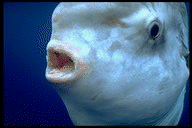

Strange, large oceanic fishes with an unusual shape. Rear of body appears to be cut-off, the caudal fin reduced to a leathery flap with a scalloped rear edge. Gill slit tiny, located just in front of pectoral fin. Mouth small; teeth united and beaklike. 1 dorsal fin opposite the anal fin, far back. No pelvic fins. Skin rough, leathery. Young - under 2 in. - have spines on the body. Molas are gray above; silvery gray-brown on side; paler or dusky below. 3 species in the family; 2 reach at least 10 ft., 3rd one grows to about 2 1/2 ft.; largest specimen estimated at 3300 lb.
Molas eat jellyfishes, but are also know to feed on other fishes and algae. They are pelagic fishes found worldwide in tropical to temperate seas. 2 species in Tropical Pacific.
Identification: Note the strange shape: body nearly oval, with a blunt rear end. Mouth tiny. 1 dorsal fin far back, opposite anal fin. Gill slit small, in front of pectoral fin. Gray to silvery. Huge - at least to 10 ft., possibly to 13 ft.; can weigh over 3000 lb., but in our area rarely weighs over 100 lb.
Range: Worldwide in tropical and temperate seas; B.C. to S. America in E. Pacific.
Habitat: Oceanic, at surface.
Remarks: Often seen "basking" at surface; sometimes jumps out of water. Flaps its dorsal and anal fins from side to side for propulsion. Occasionally caught on hook and line, also speared, gaffed, or netted. Usually heavily infested with parasites, but some people consider this fish good eating.
Similar species: Slender Mola is more elongate (body more than twice as long as it is deep) and its mouth is in a vertical slit that cannot be closed.
Identification: Similar to Ocean Sunfish but more slender (depth of body changes with growth - about 2 times as long as it is deep in large specimens). Mouth small, inside a vertical slit that cannot be closed. Dusky on back, silvery on side; usually with white streaks below the eye. To 2 ft.
Range: Tropical Pacific; San Luis Obispo Co. (cen. Calif.) to Chile; rare north of Mexico.
Habitat: Oceanic, at surface.
Similar species: Not likely to be confused with any other fish except the Ocean Sunfish.